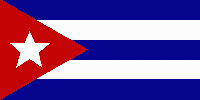 The
largest island of the West Indies is Cuba. It is one of four islands with Jamaica, Hispaniola, and
Puerto Rico that make up the Greater Antilles archipelago. Located just south of the Tropic of
Cancer in the Caribbean Sea, Cuba's western tip extends into the Gulf of Mexico between Florida
and the Yucatan Peninsula. Cuba commands three strategically located sea-lanes: the Straits of
Florida, between the Gulf of Mexico and the Atlantic Ocean; the Windward Passage, from the
Atlantic to the Caribbean between Cuba and Haiti; and the Yucatan Channel, between the
Caribbean and the Gulf of Mexico. Havana, the capital city, is on the northwest coast, 92 nautical
miles (170 kilometers) from Key West, Fla.
The
largest island of the West Indies is Cuba. It is one of four islands with Jamaica, Hispaniola, and
Puerto Rico that make up the Greater Antilles archipelago. Located just south of the Tropic of
Cancer in the Caribbean Sea, Cuba's western tip extends into the Gulf of Mexico between Florida
and the Yucatan Peninsula. Cuba commands three strategically located sea-lanes: the Straits of
Florida, between the Gulf of Mexico and the Atlantic Ocean; the Windward Passage, from the
Atlantic to the Caribbean between Cuba and Haiti; and the Yucatan Channel, between the
Caribbean and the Gulf of Mexico. Havana, the capital city, is on the northwest coast, 92 nautical
miles (170 kilometers) from Key West, Fla.
Official Name. Republic of Cuba.
Capital. Havana.
Area. 42,803 square miles (110,859 square kilometers).
Population (1991 estimate). 10,700,000; 250 persons per square mile (96.5 persons per
square kilometer); 72.8 percent urban, 27.2 percent rural.
Major Language. Spanish (official).
Major Religion. Roman Catholicism.
Literacy. 96 percent.
Highest Peak. Pico Turquino.
Major River. Cauto.
Form of Government. Socialist Republic.
Chief of State and Head of Government. President.
Legislature. National Assembly of the People's Power.
Voting Qualification. 16 years of age.
Political Divisions. 14 provinces and 1 special municipality.
Major Cities (1989 estimate). Havana (2,077,938), Santiago de Cuba (397,024), Camaguey
(278,958), Holguin (222,794), Guantanamo (197,868).
Chief Manufactured and Mined Products. Nickel, iron ore, copper, sugar, food, textiles,
cement, cigars.
Chief Agricultural Products. Crops cane sugar, tobacco, citrus fruits, rice, coffee, tropical
fruits, vegetables. Livestock pigs, horses, sheep, goats, cattle.
Monetary Unit. 1 Cuban peso = 100 centavos.
---------------------------------------------------------
Excerpted from Compton's Interactive Encyclopedia
Copyright (c) 1994, 1995 Compton's NewMedia, Inc. All Rights Reserved